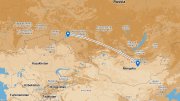Using a new technique developed at Harvard and the Max Planck Institute, scientists can identify close relatives among people who lived thousands of years ago. A study published today demonstrates how the ability to identify up to second and third cousins using ancient DNA can reveal evidence of extraordinary instances of individual migration. Comparing groups of people in this way can link archaeologically distinct cultures. It can also document population bottlenecks in ancient civilizations—including two such episodes among the earliest speakers of Indo-European languages.
Finding cousins using modern DNA is straightforward for ancestry testing companies, but doing so using ancient DNA, which is often poorly preserved or incomplete, has proven difficult. Harald Ringbauer, an associate of the department of human evolutionary biology, worked with professor of genetics and of human evolutionary biology David Reich and other colleagues at Harvard and the Max Planck Institute for Evolutionary Anthropology in Leipzig, to develop the new technique, which is described in Nature Genetics. (Ringbauer was a postdoctoral fellow in the Reich lab—famous for developing new techniques for analyzing ancient DNA—from January 2020 through early 2021. He is now a group leader at the Max Planck, and a member of the Max Planck-Harvard Research Center for the Archaeoscience of the Ancient Mediterranean, directed by Goelet professor of medieval history Michael McCormick.)
Cousins share lengths of DNA that are termed “identical by descent” (IBD) because they are inherited from a common ancestor. And relationships among groups of people based on IBD segments are detectable for a few hundred years, until the repeated recombination that occurs with each new generation breaks them into shorter and shorter lengths, eventually obscuring these traces of shared ancestry. “The shorter the segments,” Reich explains, “the less close the connections are.” In the analysis of ancient DNA, people who share multiple IBD segments are considered more closely related than those who share just one.
To demonstrate what is possible using this new analytical technique, Riech, Ringbuaer and their colleagues identified several hundred relatives among 10,156 ancient individuals who lived in Eurasia within the last 45,000 years. Two of them, perhaps first cousins once removed, had been buried more than 1,400 kilometers (nearly 900 miles) apart. One was interred in what is now southern Russia, the other in central Mongolia, evidence of a remarkable migration by these individuals or a close relative.
The researchers also linked individuals across a series of archaeologically distinct cultures involved in the spread of Indo-European languages beginning around 5,000 years ago. They showed that the Yamnaya horse-herders of the Pontic-Caspian Steppe are biologically separated from the successive Corded Ware culture by only a few hundred years. The Corded Ware people (so named for their distinctive pottery) were in turn succeeded and again closely related to the Beaker Bell culture, which spread through ongoing genetic admixture with local populations as far as Great Britain and the Iberian peninsula by 4,000 years ago. A surprising finding was that individuals associated with Copper Age farmers from what is now Poland and Ukraine (members of the Globular Amphora culture), were also closely related to Corded Ware individuals. These people had no Steppe ancestry, but clearly made a major genetic contribution to the later Corded Ware cultures that spread across Europe between 4,000 and 5,000 years ago.

The Yamnaya, the study found, are also closely related to the Afanasievo people of the central Asian Altai mountains several thousand kilometers to the east. The IBD analysis thus proves that only a few hundred years separate these geographically distant peoples—some scholars had previously hypothesized that the two groups might have descended from a common ancestral group that lived a millennium earlier. Identifying close relationships among the Yamnaya and successor cultures solidifies the theory that these horse-riding Steppe pastoralists were key to the spread of Indo-European languages.
The study also found a high degree of relatedness among members of the Yamnaya and Corded Ware cultures living in Eastern Europe just prior to their westward expansion, which is indicative of a small effective population size. “Effective population size” is a term used by population geneticists to signify the size of the procreating group, explains Ringbauer, because “not everyone who lives has kids, and some people have more kids” than any average would suggest. The effective size of a population can thus be “a bit lower than the census size.” Just how severe these population bottlenecks were, says Ringbauer, is the subject of ongoing research.








